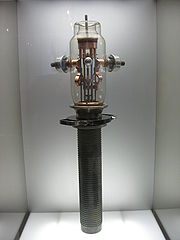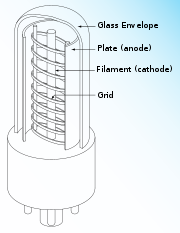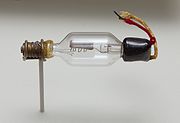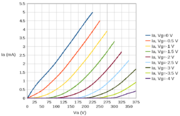
Triode
Encyclopedia


Amplifier
Generally, an amplifier or simply amp, is a device for increasing the power of a signal.In popular use, the term usually describes an electronic amplifier, in which the input "signal" is usually a voltage or a current. In audio applications, amplifiers drive the loudspeakers used in PA systems to...
device having three active electrodes. The term most commonly applies to a vacuum tube
Vacuum tube
In electronics, a vacuum tube, electron tube , or thermionic valve , reduced to simply "tube" or "valve" in everyday parlance, is a device that relies on the flow of electric current through a vacuum...
(or valve in British English) with three elements: the filament or cathode
Cathode
A cathode is an electrode through which electric current flows out of a polarized electrical device. Mnemonic: CCD .Cathode polarity is not always negative...
, the grid
Control grid
The control grid is an electrode used in thermionic valves used to modulate the flow of electrons in the cathode to anode or plate circuit.- Operation :...
, and the plate
Plate electrode
A plate is a type of electrode that formed part of a vacuum tube. The plate is impressed with a positive charge so that it may capture and flow electrons within a circuit....
or anode
Anode
An anode is an electrode through which electric current flows into a polarized electrical device. Mnemonic: ACID ....
. The triode vacuum tube was the first electronic amplification
Electronic amplifier
An electronic amplifier is a device for increasing the power of a signal.It does this by taking energy from a power supply and controlling the output to match the input signal shape but with a larger amplitude...
device. The word is derived from the Greek
Greek language
Greek is an independent branch of the Indo-European family of languages. Native to the southern Balkans, it has the longest documented history of any Indo-European language, spanning 34 centuries of written records. Its writing system has been the Greek alphabet for the majority of its history;...
τρίοδος, tríodos, from tri- (three) and hodós (road, way), originally meaning the place where three roads meet.
Invention

Lee De Forest
Lee De Forest was an American inventor with over 180 patents to his credit. De Forest invented the Audion, a vacuum tube that takes relatively weak electrical signals and amplifies them. De Forest is one of the fathers of the "electronic age", as the Audion helped to usher in the widespread use...
who developed it from his original two-element 1906 Audion
Audion tube
The Audion is an electronic amplifying vacuum tube invented by Lee De Forest in 1906. It was the forerunner of the triode, in which the current from the filament to the plate was controlled by a third element, the grid...
. The Audion did provide amplification. However it was not until around 1912 that other researchers, while attempting to improve the service life of the audion, stumbled on the principle of the true vacuum tube. The name triode appeared later, when it became necessary to distinguish it from other generic kinds of vacuum tubes with more or fewer elements (eg diode
Diode
In electronics, a diode is a type of two-terminal electronic component with a nonlinear current–voltage characteristic. A semiconductor diode, the most common type today, is a crystalline piece of semiconductor material connected to two electrical terminals...
s, tetrode
Tetrode
A tetrode is an electronic device having four active electrodes. The term most commonly applies to a two-grid vacuum tube. It has the three electrodes of a triode and an additional screen grid which significantly changes its behaviour.-Control grid:...
s, pentode
Pentode
A pentode is an electronic device having five active electrodes. The term most commonly applies to a three-grid vacuum tube , which was invented by the Dutchman Bernhard D.H. Tellegen in 1926...
s etc.). The Audion tubes deliberately contained some gas at low pressure. The name triode is only applied to vacuum tubes which have been evacuated of as much gas as possible.
There was a parallel independent invention of the triode by Austrian Robert von Lieben
Robert von Lieben
Robert von Lieben was a notable Austrian physicist.Robert von Lieben was born to Leopold von Lieben and Anna von Lieben.-Education:...
.
Operation

Diode
In electronics, a diode is a type of two-terminal electronic component with a nonlinear current–voltage characteristic. A semiconductor diode, the most common type today, is a crystalline piece of semiconductor material connected to two electrical terminals...
, the heated cathode (either directly or indirectly by means of a filament) causes a space charge of electron
Electron
The electron is a subatomic particle with a negative elementary electric charge. It has no known components or substructure; in other words, it is generally thought to be an elementary particle. An electron has a mass that is approximately 1/1836 that of the proton...
s that may be attracted to the positively charged plate (anode) and create a current. Applying a negative voltage (a 'bias') on the control grid will tend to repel some of the (also negatively charged) electrons back towards the cathode: the more negative the voltage on the grid, the smaller the current to the plate. If an AC signal is superimposed on the bias of the grid, an amplified version of the AC signal appears (inverted) across the external impedance in the plate(anode) circuit.
The triode is very similar in operation to the n-channel JFET
JFET
The junction gate field-effect transistor is the simplest type of field-effect transistor. It can be used as an electronically-controlled switch or as a voltage-controlled resistance. Electric charge flows through a semiconducting channel between "source" and "drain" terminals...
; it is normally on, and progressively switched off as the grid/gate is pulled increasingly negative of the source/cathode.
Applications
Although triodes are now largely obsolete in consumer electronicsConsumer electronics
Consumer electronics are electronic equipment intended for everyday use, most often in entertainment, communications and office productivity. Radio broadcasting in the early 20th century brought the first major consumer product, the broadcast receiver...
, having been replaced by the transistor
Transistor
A transistor is a semiconductor device used to amplify and switch electronic signals and power. It is composed of a semiconductor material with at least three terminals for connection to an external circuit. A voltage or current applied to one pair of the transistor's terminals changes the current...
, triodes continue to be used in certain high-end
High-end audio
High-end audio is a term used to describe a class of consumer home audio equipment marketed to audio enthusiasts on the basis of high price or quality, and esoteric or novel sound reproduction technologies. High-end audio can refer simply to the price, to the build quality of the components, or to...
and professional audio
Professional audio
Professional audio, also 'pro audio', refers to both an activity and a type of audio equipment. Typically it encompasses the production or reproduction of sound for an audience, by individuals who do such work as an occupation like live event support, using sound reinforcement systems designed for...
applications, as well as in microphone preamplifier
Preamplifier
A preamplifier is an electronic amplifier that prepares a small electrical signal for further amplification or processing. A preamplifier is often placed close to the sensor to reduce the effects of noise and interference. It is used to boost the signal strength to drive the cable to the main...
s, electric guitar amplifier
Guitar amplifier
A guitar amplifier is an electronic amplifier designed to make the signal of an electric or acoustic guitar louder so that it will produce sound through a loudspeaker...
s and high power RF
Radio frequency
Radio frequency is a rate of oscillation in the range of about 3 kHz to 300 GHz, which corresponds to the frequency of radio waves, and the alternating currents which carry radio signals...
amplifiers and transmitter
Transmitter
In electronics and telecommunications a transmitter or radio transmitter is an electronic device which, with the aid of an antenna, produces radio waves. The transmitter itself generates a radio frequency alternating current, which is applied to the antenna. When excited by this alternating...
s.
Some guitarists routinely drive their amplifiers to the point of clipping (either grid-current limiting or valve cut-off), in order to produce a desired distortion
Distortion
A distortion is the alteration of the original shape of an object, image, sound, waveform or other form of information or representation. Distortion is usually unwanted, and often many methods are employed to minimize it in practice...
tone (tube sound
Tube sound
Tube sound is the characteristic sound associated with a vacuum tube-based audio amplifier. The audible significance of tube amplification on audio signals is a subject of continuing debate among audio enthusiasts....
). Many people prefer the sound of triodes in such an application, since the distortion of a tube amplifier, which has a "soft" saturation characteristic, can be more pleasing to the ear than that of a typical solid-state
Solid state (electronics)
Solid-state electronics are those circuits or devices built entirely from solid materials and in which the electrons, or other charge carriers, are confined entirely within the solid material...
amplifier, which through negative feedback is linear up to the limits of its supply voltage and then clips
Clipping (audio)
Clipping is a form of waveform distortion that occurs when an amplifier is overdriven and attempts to deliver an output voltage or current beyond its maximum capability...
abruptly.
Characteristics

In the example characteristic shown on the image, if an anode voltage Va of 200 V and a grid voltage bias of -1 volt are selected, a plate (anode) current of 2.25 mA will be present (using the yellow curve on the graph). Changing the grid voltage will change the plate current; by suitable choice of a plate load resistor, amplification is obtained.
In the class A triode amplifier, an anode resistor would be connected between the anode and the positive voltage source. For example, with Ra=10000 Ohms, voltage drop on it will be
VRa=Ia×Ra=22.5 V,
if anode current of Ia=2.25 mA is chosen.
Now, if the input voltage amplitude (at the grid) changes from -1.5 V to -0.5 V (difference of 1 V), anode current will change from 1.2 to 3.3 mA (see image). This will result in anode resistor voltage drop changes from 12 to 33 V (difference of 21 V).
Since grid voltage changes from -1.5 V to -0.5 V, and anode resistor voltage drop from 12 to 33 V, amplification of signal resulted. Amplification factor is 21 - output voltage amplitude divided by input voltage amplitude.

